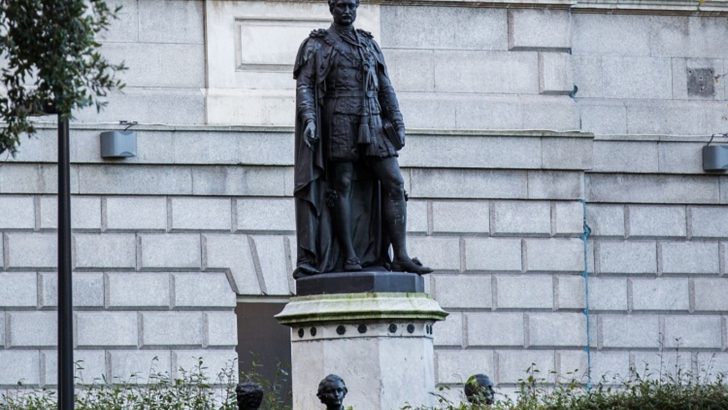Discovering Thomas Moore: Ireland in 19th Century Europe
Royal Irish Academy, Academy House, 19 Dawson Street, Dublin 2.An exhibition running to Monday, December 23, 2019; opening hours: Monday-Friday, 10am-4.30pm, no booking required.
Booklet to accompany the exhibition by Sarah McCleave
(Queen’s University / Erin Project / Royal Irish Academy), free.
Thomas Moore, once deemed in the 19th Century to be Ireland’s premier poet, suffered badly at the hand of the Irish Literary Revival (not to speak of the Irish revolution).
Joyce, for instance describes how Stephen passes “the droll statue of the national poet of Ireland” in College Street, outside Trinity College, which he thought “was a Firbolg in the borrowed cloak of a Milesian” – the very phrase betokens the studied snobbery of Irish nationalism.
Others too sneered at Moore: Frank O’Connor, Patrick Kavanagh, Austin Clarke. Efforts are made from time to time to raise Mangan to Moore’s status, but these always fail.
The current display at the Royal Irish Academy, which will be supported by a series of lectures through October, will go a very long way to reveal the poet in his true dimensions to a younger generation and place the poet as a figure in European culture as Ireland greatest contribution to the pan-continental Romantic era, in which the identity of modern Europe was created .
To pick up on Joyce’s disdain, Moore was no mere “man of the bags”, an earth-hauling slave. Far from being a Firbolg, he was a middle class Dublin poet in the Irish tradition, a bard wrapped in a glorious cloak of his own creation, a coat of many colours.
The items, often rare and unusual, are displayed to illustrate various aspects of the poet’s career. The attractive booklet that accompanies the show has an introduction by Prof. Harry White, but is largely the work of Sarah McCleave. It emphasises Moore’s overall significance in the wider cultural scene, of which his attitudes to Ireland , though well discussed here, are only a part.
Thomas Moore’s success as a writer is grounded in his profound response to his education”
His History of Ireland and his biography of Byron are given their due weight, but the most interesting part deals with “Moore and Orientalism” – here given a positive interpretation – opening out what will be for many a little known aspect of his work, but the one which gave him in his own day his greatest fame among lover of poetry.
“Moore was at his most European when writing about the orient,” Dr McCleave notes.
Lalla Rookh excited considerable interest across Europe, stimulating several translations in German, French, Italian, and Spanish before the end of the 19th Century.”
She also deals with Moore at work both as a poet and author. “Thomas Moore’s success as a writer is grounded in his profound response to his education. One of a rare group of pupils to read Greek and Latin at Samuel Whyte’s Academy on Grafton Street, Moore studied for a Bachelor of Arts Degree in Trinity College, graduating in 1799.”
Can it be that he was simply better educated than many of his Irish critics?
Aside from his uses of Irish sources for his work, we are shown how he handled not only oriental tales, but also the Koran (in George Sale’s once famous version). All of this chimes in with the increasing interest these days in trying to truly understand Arab, Persian and Muslim cultures.
Moore was also a Catholic, but a man with a tolerant accepting attitude to religion, which again chimes with the feelings of many today. He is one of the rare Irish writers to take a real interest in religion, and he shows in his Travels of an Irish Gentleman in search of Religion – the copy of this book displayed is from the old Redemptorist Library in St Alphonsus Church in New Orleans.
These exhibits should inspire a whole new interest among general readers in this important poet. The booklet has a two-page list of further reading, enabling the visitor to follow up on particular aspect of Moore’s life, work and influence. This is a show which can be warmly recommended.
Achievements
The more one considers Moore and his wide ranging achievements the more one comes to realise that he is indeed an important figure in not just Irish literature, but in European literature. He well deserves the recognition of this status, which his countrymen have long denied him.
Joyce may have been blind to Thomas Moore’s true stature; though not deaf to them for he often sang some of Moore’s melodies here and in exiles. But there is no need for the modern readers, especially those with an interest in the literary history of Dublin, to be that way.
(The exhibition is supported by a series of five lunch-time lectures beginning on October 9 with ‘Re-imagining Moore’ by Prof. Harry White MRIA, School of Music, UCD. More information on these can be found at www.ria.ie, or by email at info.ria.ie.)


 Peter Costello
Peter Costello Thomas Moore Statue photo by Caroline Brady
Thomas Moore Statue photo by Caroline Brady 